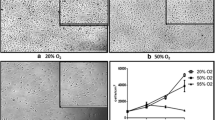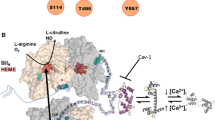Abstract.
Cultured bEND.3 endothelial cells show a marked increase in NO production when subjected to anoxia, even though the normal arginine pathway of NO formation is blocked due to absence of oxygen. The rate of anoxic NO production exceeds basal unstimulated NO synthesis in normoxic cells. The anoxic release of NO is mediated by endothelial nitric oxide synthase (eNOS), can be abolished by inhibitors of NOS and is accompanied by consumption of intracellular nitrite. The anoxic NO release is unaffected by the xanthine oxidase inhibitor oxypurinol. The phenomenon is attributed to anoxic reduction of intracellular nitrite by eNOS, and its magnitude and duration suggests that the nitrite reductase activity of eNOS is relevant for fast NO delivery in hypoxic vascular tissues.
Similar content being viewed by others
Author information
Authors and Affiliations
Corresponding author
Additional information
Received 20 August 2006; received after revision 21 September 2006; accepted 8 November 2006
Rights and permissions
About this article
Cite this article
Vanin, A.F., Bevers, L.M., Slama-Schwok, A. et al. Nitric oxide synthase reduces nitrite to NO under anoxia. Cell. Mol. Life Sci. 64, 96–103 (2007). https://doi.org/10.1007/s00018-006-6374-2
Published:
Issue Date:
DOI: https://doi.org/10.1007/s00018-006-6374-2




